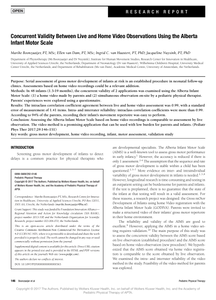Background: Current use of smartphone cameras by parents create opportunities for longitudinal home-video-assessments to monitor infant development. We developed and validated a home-video method for parents, enabling Pediatric Physical Therapists to assess infants’ gross motor development with the Alberta Infant Motor Scale (AIMS). The objective of the present study was to investigate the feasibility of this home-video method from the parents’ perspective. Methods: Parents of 59 typically developing infants (0–19 months) were recruited, 45 parents participated in the study. Information about dropout was collected. A sequential mixed methods design was used to examine feasibility, including questionnaires and semi-structured interviews. While the questionnaires inquired after the practical feasibility of the home-video method, the interviews also allowed parents to comment on their feelings and thoughts using the home-video method. Results: Of 45 participating parents, 34 parents returned both questionnaires and eight parents agreed to an interview. Parent reported effort by the infants was very low: the home-video method is perceived as similar to the normal routine of playing. The parental effort level was acceptable. The main constraint parents reported was time planning. Parents noted it was sometimes difficult to find the right moment to record the infant’s motor behavior, that is, when parents were both at home and their baby was in the appropriate state. Technical problems with the web portal, reported by 28% of the parents were also experienced as a constraint. Positive factors mentioned by parents were: the belief that the home videos are valuable for family use, receiving feedback from a professional, the moments of one-on-one attention and interaction with their babies. Moreover, the process of recording the home videos resulted in an increased parental awareness of, and insight into, the gross motor development of their infant. Conclusion: The AIMS home-video method is feasible for parents of typically developing children. Most constraints are of a practical nature that can be addressed in future applications. Future research is needed to show whether the home-video method is also applicable for parents with an infant at risk of motor development problems.
DOCUMENT

The purpose of this study was a serial assessment of gross motor development of infants at risk is an established procedure in neonatal follow-up clinics. Assessments based on home video recordings could be a relevant addition. In 48 infants (1.5-19 months), the concurrent validity of 2 applications was examined using the Alberta Infant Motor Scale: (1) a home video made by parents and (2) simultaneous observation on-site by a pediatric physical therapist. Parents’ experiences were explored using a questionnaire.
DOCUMENT

Objective To evaluate whether a specific period after birth (in weeks postmenstrual age [PMA]) and specific elements of sucking are associated with abnormal neurodevelopmental outcomes at age 2 years using a longitudinal approach.Study design Fifty-two preterm infants participated in this longitudinal cohort study (mean gestational age,29.5 weeks; mean birth weight, 1197 g). We assessed the infants’ sucking patterns at 37-50 weeks PMA using the Neonatal Oral-Motor Assessment Scale. At age 2 years, based on a neurologic examination and the Dutch version of the Bayley Scales of Infant and Toddler Development, Second Edition, we categorized the children as developing normally (n = 39) or abnormally (n = 13). ORs, including 95% CIs, were calculated to ascertain the risk of abnormal neurodevelopmental outcomes.Results The inability to sustain sucking at 46 weeks PMA (OR, 6.25; 95% CI, 1.29-30.35) and the absence of amature sucking pattern at 44 weeks PMA (OR, 6.30; 95% CI, 1.40-28.32) significantly increased the odds ofabnormal neurodevelopmental outcomes at age 2 years. The ORs of the Neonatal Oral-Motor Assessment Scale items assessing rhythmic jaw movements, rhythmic tongue movements, and coordination among sucking, swallowing, and respiration were high shortly after term, but failed to reach significance.Conclusion Specific elements of sucking at 4-6 weeks postterm are associated with abnormal neurodevelopmental outcomes in preterm infants at age 2 years. This period might be a sensitive time of infant development in which sucking behavior is an early marker of abnormal developmental outcomes. This finding may offer opportunities for early intervention.
DOCUMENT